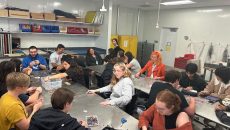(Photo Courtesy of Mohamed Badarne) “Kimberle Crenshaw, American civil rights advocate and a leading scholar of critical race theory.”
Kyra Barry
Connector Editor
Intersectionality is essential to social justice or at least acknowledging the concept is. Although what the term represents has existed before intersectionality was used in the social justice movement, it was coined in the 90s by a black legal scholar and an American civil rights advocate named Kimberle Williams Crenshaw. Many concepts and ideas vital to the social justice discussion were invented by black women.
“I just have so much respect for [Kimberle Crenshaw],” Chandra Waring, Assistant Professor in the Sociology Department says. “Her work is a…recognition of black women’s experiences, and it’s a way for people to recognize when someone is experiencing… more than one form of oppression…I talk about it with reverence because I think she’s brilliant.”
At its core, intersectionality is a way to give voice and legitimize those who experience an overlap in discrimination. At the time of coining the term, Crenshaw noted there was no legal stance for black women who were experiencing both sexism and racism in the work place. One issue was addressed or the other, not the combination of both.
June 26, 2015 the Supreme Court of the United States legalized same-sex marriage, striking down remaining bans in all fifty states. Many were jubilant, rejoicing that marriage equality now existed in the United States. For many disabled citizens interested in same-sex marriage or otherwise, this is still not true. The way disability aid exists in the United States, resources exist for those unable to easily attain them themselves until a point where it is deemed they are able to do so. When they get married, their joint income and assets are assessed, and that is sometimes enough to deprive those who need their benefits. A supposed resounding victory rings hollow for some, especially those who are in the LGBTQ+ community and disabled.
It’s no coincidence that Crenshaw, a black woman, brought into existence the term intersectionality to define an already existing phenomenon. Her lived experiences allowed her a perspective to acknowledge the difficult reality of being affected by multiple forms of discrimination.
“In American society, it’s been either racism or sexism. Can’t do both right? Which is why black women and other women of color…have been kind of left out in the dust or told like we should be happy with scraps at the table,” Waring said about her own experience as a biracial black woman and how it relates to the larger picture.
There are several ways UMass Lowell can take into account intersectionality in its policy making, according to Waring. Educational workshop for its members, especially its white administrative members and a concerted effort to fill positions with diverse perspectives. Instead of accepting that systems have lead to positions of authority being filled by white men or white women, the university can specifically put in job ads that those applying be BIPOC, part of the LGBTQ+ community, disabled, etc. Not in a way to mark a check list, but to ensure that their administrations are intersectional in nature. Those putting forth policies should be those who will be affected by policies.
Waring said “I think that what [intersectionality] does is it allows us to again recognize our shared overlapping experience and work towards change, but it also allows us to be more accurate… There are certain types of experiences that black women have that black men don’t have, white women don’t have, and those experiences need to be honored.” It would behoove the university to keep these experiences in mind, especially as it comes to their faculty. Keeping in mind biases and subconscious thought processes and how those might affect faculty interactions with the student population and vice versa is important.
For example, individuals who come from middle class backgrounds won’t have the perspective of those who come from low income backgrounds on policies affecting financial aid. Trans students and those who fall under the diverse gender umbrella and their perspectives resonate differently than cis people’s perspectives. Where those identities intersect, for example in poor trans students, provides invaluable perspectives. The collaboration between communities who face different oppressions will ultimately better all communities.
“When we go back to my point, when we acknowledge intersectionality…here’s what we need to be doing. We need to recognize that these types of people who belong to these communities have different types of experience.”




